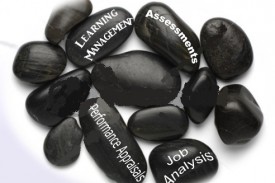
The vast majority of organizations that use any form of human resource or organizational development tools have to mix and match tools that are not aligned or integrated in any way. The tools that they are sold are supposed to fit together, they appear to be similar in many ways, but operationally, the organization is left with something that looks more like a pile of rocks than a foundation for a high performing workforce.
The job analysis for their competency model is conducted by one group, their assessments are purchased from a separate vendor, their performance appraisal is procured through a third source, and learning management comes from their favorite training provider! This leaves internal staff and management with the monumental task of mixing and matching pieces that appear to have come from different puzzles. For example, over 90% of companies that use a job applicant selection tool, such as a personality assessment, do not have a performance appraisal that is aligned to the assessment in an integrated system. These companies select employees based on a set of dimensions that are supposed to predict job performance, but then the internal staff are left to try to understand how the assessment dimensions have anything to do with their job competencies when evaluating the effectiveness of their processes. Most companies are left with the choice of hiring a consultant to sort out the mess, decide that the tools do not work, or, the tools are not worth the effort to implement. In many cases, if and when the results across tools are interpreted, the overall return on investment is much less than expected, because the key to HR and OD tool effectiveness is to use aligned tools in an integrated, strategic system.
HR and OD researchers have known for over 30 years that mixing and matching HR tools does not lead to company success. Research has consistently shown that integrated, or strategic, human resource management approaches transform HR into a profit center for businesses through reduced workforce costs and substantial gains in company performance. For example, in 1980, McKinsey reported that out of a sample of the fifty largest US corporations, nine were most successful were because of strategic human resource practices. It was not a difference in just using good HR processes and tools; it was if the tools were used in a strategic (i.e., aligned) manner.

